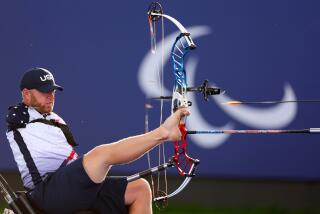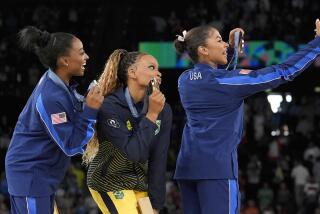Date With a Target : Rabska’s Love for Bow and Arrow Leads to Archery Title
- Share via
Don Rabska, now a champion archer, gave a strong indication ofwhere his life was headed at a very early age. He watched old cowboy-and-Indian movies. And he rooted for the Indians. They, you see, were the ones with the bows and arrows. And Rabska loved bows and arrows with the same passion most kids save for BB guns.
Another strong hint about Rabska’s love of bows and arrows is that he was a four-time archery All-American, and the 1975 national collegiate champion, while attending San Bernardino Valley College. The unusual thing here is that San Bernardino Valley College is only a two-year school. Let’s just say he was never crushed by his course load.
Rabska’s first bow, acquired as a present at the age of 8, was made of cheap fiberglass. When the original string broke, he used an old boot lace to propel his wooden arrows, arrows that hit their mark with all the accuracy of one of Geraldo Rivera’s questions. Well, OK, Rabska’s arrows didn’t end up that far off target. But you get the idea.
The 32-year-old still shoots arrows. Sometimes hundreds a day. And his bow is not cheap fiberglass, his boot laces stay in his boots and the arrows fly straighter than Anita Bryant. Last weekend, Rabska out-twanged the finest archers in the United States to win the trials of the National Archery Assn. tournament in Oxford, Ohio. The tournament is sponsored by the Federation of International Target Archery. The win gave Rabska the No. 1 berth on the U.S. squad for November’s Championship of the Americas tournament at Rio de Janeiro.
Rabska works for Van Nuys-based Easton Aluminum, which is to target archery what gross overeating is to Tom Lasorda. Archers using Easton arrows have won every major archery tournament in the world in the past 10 years. Rabska is Easton’s special projects manager and technical archery adviser. He also has a third title, Aero Product Manager, which means he’s in charge of arrows. That tells you pretty much all you need to know about the level of sophistication and technology that bows, which cost upwards of $300, and arrows, which can cost $20 each, have reached.
From the days when kids got a bow and a quiver filled with rubber suction cup-tipped arrows and thought it was really funny to make one of them stick on their kid brother’s forehead from about 20 feet, archery has evolved to a point where a new language is necessary to discuss it. Did you know, for instance, that at Easton, “After anneal, the tubes (arrows) are drawn over a mandrel and through a die, reducing both the outside diameter and the wall thickness uniformly?”
Most people don’t know “anneal” from Neil Sedaka. As for being drawn over a mandrel, most male country and western fans would probably ask, “Which one, Barbara or Louise?”
Or did you know that, “The nock end of the arrow shaft is tapered by swaging?”
Don’t feel bad. Most people didn’t know that. But Rabska and hundreds of other world-class archers know all about nock ends and swaging and other things that affect the 160-m.p.h. flight of an arrow.
“The technical aspects of archery have come a long, long way,” he said. “We use space-age material now where we used to use wood. The sport is highly technical. But at the same time, it’s still a bow and arrow. We have a sight to aim with, and stabilizer bars. But we still have to hold it dead still and we still have to release the arrow by hand. The technology has jumped, but it’s still basic archery.”
The sight Rabska referred to is mounted on the bow. It has settings for all competition shooting distances--30, 50, 70 and 90 meters--and a glowing orange dot in the center, much like a rifle scope. It appears capable of homing in on a Soviet missile. There are usually two stabilizer bars on the bow that point back at the archer and a third that hangs far out in front of the bow. Their purpose is much the same as the long balancing pole carried by circus high-wire walkers.
Rabska used to go bow hunting for big game in Colorado each fall. He used the skills he had honed on archery ranges to kill two mule deer. The last one, in 1974, was indeed his last one.
“I got the Bambi syndrome,” he said. “I felt really bad after I had killed him. Big brown eyes and all that stuff. I just lost interest in it. I couldn’t do that again.”
So he began channeling all his energies toward target shooting. Hours and hours each week, every week, for years, he practiced. And last weekend, all the work culminated in his victory at the prestigious Grand FITA, where he defeated the best in the nation, including 1984 Olympic gold medalist Darrell Pace, as well as famed archers Rick McKinney and Jay Barrs.
But his biggest moment of glory was dimmed by the whining of some of the other top competitors, including Pace, who claimed the new international format for archery tournaments has tainted the sport. The new format consists of separate rounds of 36 arrows each in which the starting field is gradually eliminated and the competition comes down to one 36-arrow shoot-off. The traditional format involved four days of competition during which every archer shot 288 arrows and the highest overall score determined the winner.
“The new format is an unfair test for the top shooters,” Pace complained from his home in Hamilton, Ohio. “It gives the lesser guys a chance to win the big titles or make the big teams just by having one or two lucky rounds of shooting. It doesn’t credit overall performance, which is how archers should be judged. The new system should be called the Grand FITA Lottery. Anybody can win. In my opinion it is a direct attempt to eliminate the top two archers in the world--me and Rick McKinney. Both of us have cleaned house rather well. Now it looks like they’re cleaning our house.
“Rabska had one good day. He knows that.”
In the national championship tournament held over four days prior to the FITA event, Pace finished first, followed by McKinney and Barrs. Rabska was fourth. Pace made the team for the Championship of the Americas tournament by finishing third, but McKinney was bumped from the team--the first time in several years he had failed to earn a spot on a major U.S. squad--by finishing sixth.
Rabska, as a member of the technical committee of FITA (Federation of International Target Archery), helped mold the new format. As the vice president of the National Archery Assn., he helped implement it in U.S. tournaments.
“I know Darrell is critical of me and of the new format, but I wish he wouldn’t be,” said Rabska, who served as the director of archery competition at the Los Angeles Olympics.
“This new format is important because for the first time, it gives the spectators something interesting to watch. The old format would have guys, often Darrell and Rick, ahead by huge, insurmountable margins heading into the final round. You knew who was going to win. It just wasn’t interesting. And with so many other sports bidding for acceptance into the Olympics, it was decided we had to liven up the competition a bit.”
A word here about watching archery competition: Boring. The spectators are the length of a football field away from the target in the final rounds, and those with really good eyesight can actually see the target. None of them can see where the arrows are going. For all the fans know, the arrows are sailing over the targets and lodging in the side of a bread truck across the street. And in the old format, where an archer could have a lead too large to lose, it didn’t matter if he hit the truck. The new system eliminates those huge leads and adds some suspense, but the targets are still too far away for spectators to see the action.
When Rabska won the biggest competition of his life last weekend, he defeated 459 other archers. On hand to witness his shining moment were 150 spectators, virtually all of them relatives or close friends of the competitors.
“This just isn’t a mass spectator sport,” he said. “We want bigger crowds, and I think we’re moving in the right direction with this new tournament format. But it will always be disappointing, I think, from a crowd viewpoint. It bothers all of us a little. But fencers and team handball players have the same problem.”
There is one solution, of course, to the problem of having spectators too far from the action. Put the fans right up against the targets, or even behind them. But this, obviously, is an unreasonable proposal. For despite the space-age technology used to produce bows and arrows, archers still depend largely on their ability to concentrate. Unruly fans moving around the targets would be much too great a distraction.


